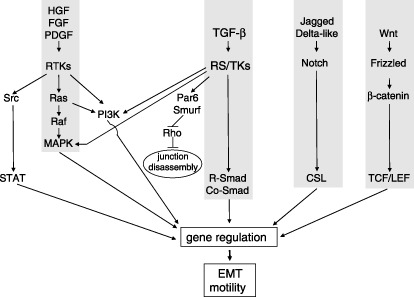Figure 2.

Major signal transduction pathways that induce epithelial–mesenchymal transition (EMT). Hepatocyte growth factor (HGF), fibroblast growth factor (FGF) and platelet‐derived growth factor (PDGF) signal via receptor tyrosine kinases (RTK) towards the central Ras‐Raf‐MAPK pathway or towards the PI3K pathway and the Src‐STAT pathway. Transforming growth factor (TGF)‐β signals via receptor serine/threonine kinases (RS/TK) towards the central R‐Smad/Co‐Smad pathway or towards the PI3K and MAPK pathways. Alternatively, the TGF‐β receptor signals towards the polarity protein Par6, thus recruiting the ubiquitin ligase Smurf, which degrades Rho and leads to disassembly of tight junctions in epithelial cells. Jagged and Delta‐like ligands signal via Notch receptors towards the transcription factor CSL. Wnt ligands signal via Frizzled receptors towards β‐catenin and the transcription factors LEF‐1/TCF. All these pathways modulate gene expression and lead to EMT and cell motility.
